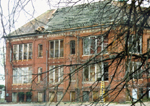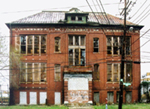|



Click These Thumbnails For Large, Higher Resolution Images
These images are intended for viewing at large size to show each section of the building's details.
To see details, adjust your software viewer to display these images larger than "full screen".
|
Some news from the 1911 Evening Star has a shockingly familiar ring. The DC schools were countering congressional complaints about the pace and cost of building repairs, and that the Board of Education was striving to meet its goal of a working fire gong in every school. Asbestos was still considered a wonder material, but the Board was addressing environmental concerns about typhoid in school water.
But in 1911 the overriding fact was that the Washington, DC school system was rigidly segregated. During that year the case of Isabel Wall was working its way through the school bureaucracy and into the Court Of Appeals, which ruled in late winter that she was (in the language of the day) “colored” and must therefore attend a “colored” school.
During 1910 and 1911, school enrollment, and especially African-American school enrollment, burgeoned. The Board of Education authorized four new schools, including a modern brick structure in the industrial Ivy City neighborhood along the B&O right-of-way on the northeast edge of the city. The new Ivy City school, which was formally classified as “colored”, was erected during the spring and summer of 1911 by contractor Alan Howison at a cost of just over $44,000. It was named for Alexander Crummell, an abolitionist, Episcopal priest and early Pan-Africanist. Crummell, who late in life so impressed W.E.B. Dubois that “Instinctively I bowed before this man, as one bows before the prophets of the world”, spent the last 25 years of his life in Washington, being appointed "missionary at large of the colored people" in 1873, founding St. Luke’s Church in 1880 and starting the American Negro Academy, the first major learned society for black Americans, in 1897.
The Crummell School dedication on November 23, 1911 was a gala event which reached beyond the immediate community. It included addresses by Superintendent of Schools Dr. William Davidson and several members of the Board of Education, as well as by Reverend G.W. Brent of the Ivy City Citizens Association. J.W. Crowell presented an oil painting, the gift of the Negro Society for Historical Research in New York, while Roscoe C. Bruce, “Assistant Superintendent of Colored Schools” presented the keys to the building. In the days before separation of church and state was not quite the issue it would become, Reverend Erasmus Lewis delivered the innvocation and Reverend M.W. Clair pronounced the benediction.
Over the years the fortunes of Ivy City moved in parallel to those of the railroad, and those of the Crummell School in parallel to those of the community. Despite an active civic association, today Ivy City is an hardbitten neighborhood whose blocks of flat-faced utterly plain apartment duplexes are pitted with vacant and vandalized units. A callus of warehouses, commercial garages, and fleet parking lots between the residential blocks and the heavy traffic on New York Avenue NE has also enveloped Crummell School, which stands where Central Place, the Ivy City’s old main street, deadends into Gallaudet Street NE.
In June, 2000, a City Paper cover story described Crummell's sad history, since the last students departed in the 1960s. During the 1970s a community group turned the property into a preschool, library, job training and daycare center, but eventually the daycare center was shut by a burglary and in 1980 the school annex burned in an unsolved arson. During the late 1990s, the property was used by an auto auction, which has since moved on.
Today this proud symbol shows many symptoms of a dying building, with shattered glass and collapsing window frames. A large section of the metal roof has been lost, perhaps to scavengers, and classrooms below appear open to the rains through warped sleathing and naked rafters. At the time that historic schools across the district are finding new life as housing, will Crummell be saved?
UPDATE: The Historic Preservation Review Board placed the Crummell School on the DC Register of Historic Sites at its May, 2002 meeting.
|
|